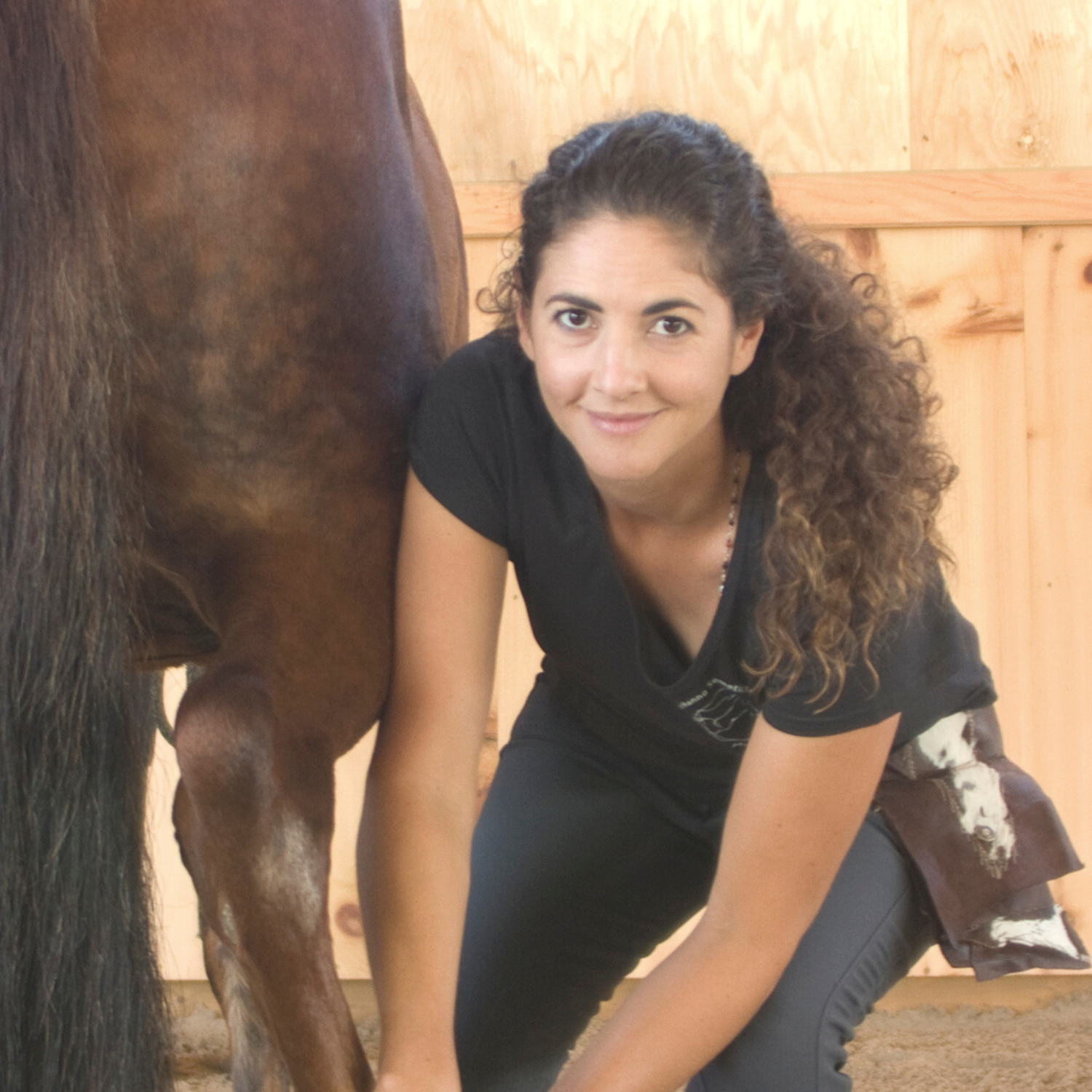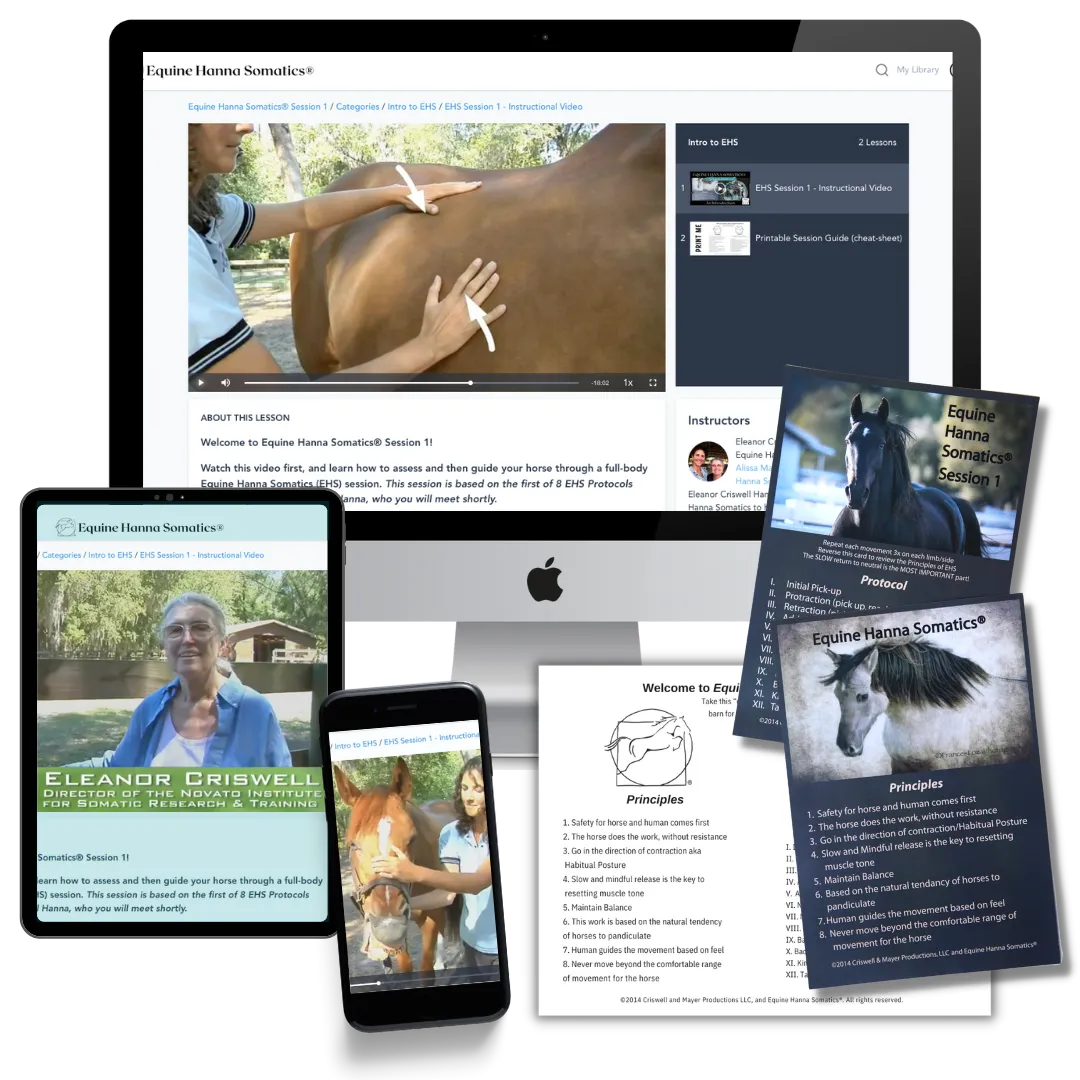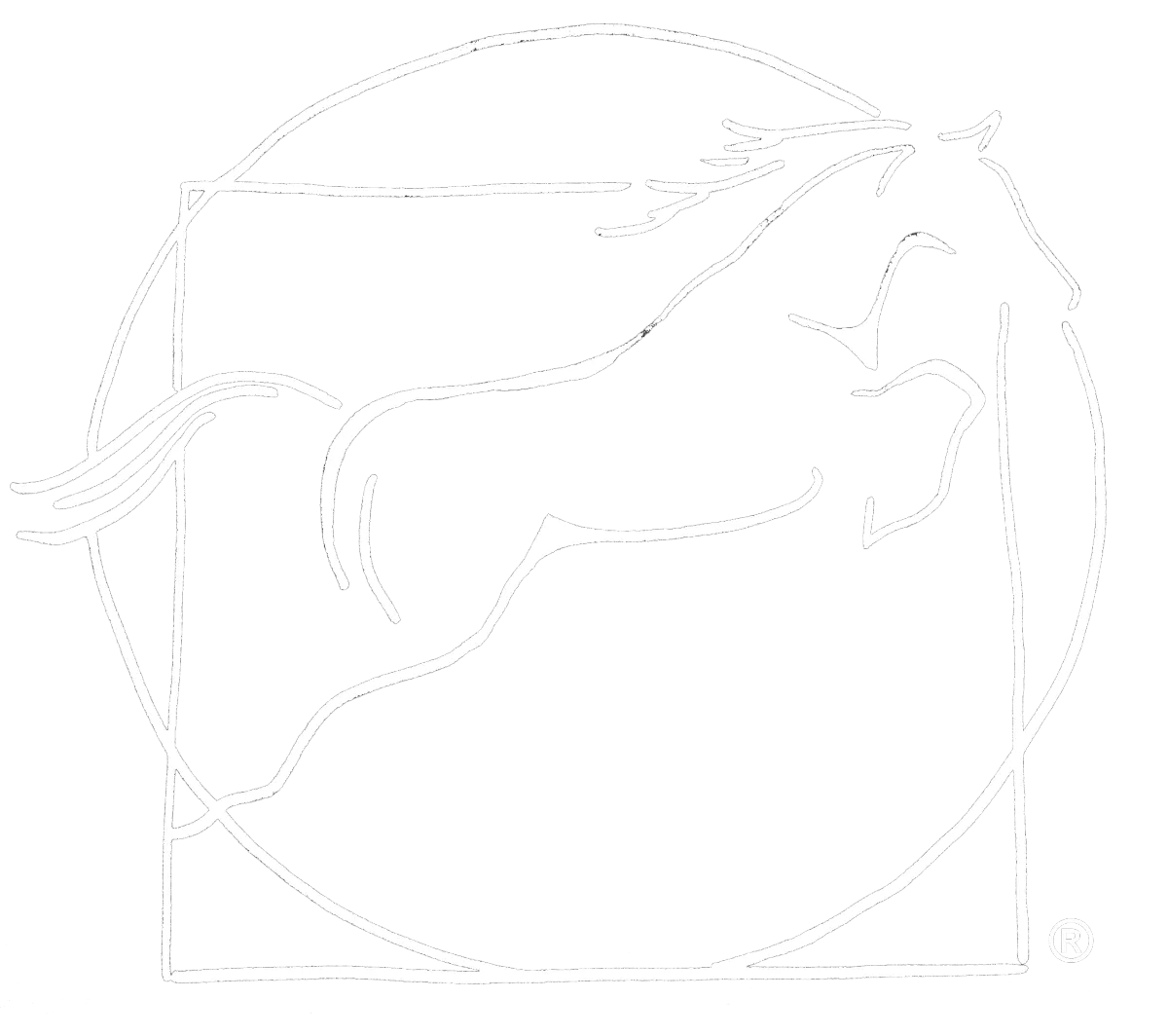Indications, Contraindications & How often do horses need Equine Hanna Somatics® (EHS)?
How often should we schedule Equine Hanna Somatics® (EHS) sessions for our horses and clients?
Like so many things with horses, it depends...
Is it for maintenance? Performance Enhancement? Rehab? Relationship building? To address a chronic somatic issue?
Here's what we teach in the EHS Professional Training Program
Scheduling a cluster of the first 3 EHS sessions in the first week for a new horse, (or one per week for 3 weeks, if that works better for you) can be ideal for several reasons:
1: The first EHS session is a brand new experience for most horses, even if they have had a lot of 'bodywork' before, so there is quite a learning and trust-building curve for many of them.
This means that for some horses, they are not able to participate fully in the first session, mentally or physically, and in some cases the first session is shorter because the horse may feel overwhelmed or overstimulated, or longer because the horse may need more 'processing' time or walk breaks, etc.
In contrast, as you are doubtless experiencing if you are doing this work with horses, the SECOND EHS session is often completely different, with the horse often eagerly waiting for you 'at the gate' and ready to participate from the first minute of their session.
This means you'll likely get a lot more 'done' because the horse is trusting, willing and actively participating (because of the learning and confidence-building you did in the first session), and because the horse is likely more comfortable and present 'in their body' - also resulting from what you and the horse 'got done' in that first session.
2. Although the many beneficial results from the EHS are both cumulative and semi-permanent, the horse will most likely go back into the same environment, same training, same tack and same rider, etc. so will be exposed to some of the same stressors that may have been contributing to his or her habitual posture. This means that the horse may continue to reinforce their existing contracted muscle habits by repeating their same old patterns daily. In some cases, a horse who hasn't fully normalized their muscle tone may start to re-acquire some of the habitual muscle contractions more quickly than they would if they have shifted all the way (or closer) back to neutral.
However, they will NOT re-learn ALL of the same patterns again, even if nothing in their environment or daily life changes, because for most horses, a significant portion of their persistent chronic muscle tension was learned in response to stimulus from their past lived experiences, and is not related to anything in their present environment - at all. In either case, you have some flexibility with your schedule, as habituation generally takes much longer than the near-instant resetting that is possible with EHS.
3. Each EHS session exponentially improves the horses ability to think, to self-organize and maintain homeostasis (even if you are not always seeing dramatic before/after results in posture), which creates exponential increases in their resilience to stressors, both old AND new - this means they will be less easily startled or stressed in general as well as less likely to re-acquire old patterns even when exposed to the same levels of stress or repetition.
4. No need for rest or 'recovery' between sessions, because we are truly working WITH, not ON, the horse.
What does 'WITH not ON' mean in the context of EHS? It means we are asking the horses to actively change their own motor output during all phases of muscle contraction, rather than asking them to feel and respond in some way to the sensory input we provide.
We facilitate this via the natural nervous system processes initiated by Voluntary Pandiculation (the innovative technique developed by Thomas Hanna in the 1980's, named and then later adapted by Eleanor Criswell for working with horses and dogs). These processes are INTERNALLY MEDIATED from start to finish - so there is no risk of accidental manual decompensation, no required 'recovery' period, no concept of "they will get worse before they get better" and no need for rest or time-off between sessions or from their work/training other than letting them have the rest of the day and night off after each EHS session to allow time for the horse to integrate their changing body awareness and range-of-motion.
In some rare cases, a horse may feel a little sore or extra sensitive for a day or two following EHS, as their muscles come back 'online,' circulation is restored and awareness is enhanced.
Can you do too much Equine Hanna Somatics?
It's near-impossible to do 'too much EHS' and hurt a horse or 'relax them too much,' or to accidentally remove an adaptive compensation pattern they were actively relying on, UNLESS you don't follow the principles of doing EHS, and instead you apply the EHS protocol 'to' horse as bodywork or manual manipulation. Even if you do it gently or with the horses consent, if the practitioners brain is producing more motor output than the horses brain, then they will not be successful at getting the horse to voluntarily pandiculate - which is the KEY to the dramatic and long-lasting results of EHS. Done correctly, in EHS we aren't doing any of it TO the horse, but are facilitating the horse in making only those changes they are able and ready to make for themselves...
During the integration period after each session, many horses will appear very sleepy, uncoordinated or wobbly and 'loosey-goosey' as they move around. This is due to the horse needing time and movement to update their internal body-map to match their new reality of changed resting muscle tonus and expanded range-of-motion, and this usually takes anywhere from 20 minutes to a couple of hours.
IF, as happens every once in a while, the horse does relax and reset a muscle contraction they still need to maintain for stability, function or comfort, during the integration period they will discover this and automatically start to compensate again, as needed.
Indications for Equine Hanna Somatics
EHS is based on the natural tendency of horses to pandiculate, and all of the movements in our protocols are the natural movements of the animals - so are safe for all ages and stages of equids. Because in EHS we are asking the horse to move their own body around, using their own neurons and myofascial tissues to do so, there are some specific indications and contraindications for determining when EHS is appropriate for each horse.
EHS is not bodywork, but is a slow and gentle form of intrinsic movement work that we facilitate for each horse. In addition to the horse giving us permission to share space with them and touch their bodies, we need each horse's active participation to do our Voluntary Pandiculation exercises. So the most important indication for EHS is that the horse (and their owner) are receptive to the work.
EHS is indicated anytime that motor-sensory amnesia (MSA) is a factor, (either to reverse existing MSA or the prevention of future MSA is desired), or when goals include performance or cognitive enhancement and to generally improve a horse's well-being.
To participate in EHS, the horse will be contracting their muscles and moving their body around slowly, so it's important that the horses don't have any acute injuries, or are far enough along in their rehabilitation that the veterinarian has given them permission to begin light work (like hand-walking) before beginning EHS.
Contraindications for Equine Hanna Somatics
EHS is beneficial for most horses to address the habitual muscle contractions, postural deviations and other somatic issues caused by MSA, as well as a wonderful bonding experience between horse and handler. Because of it's gentle nature, there are not many contraindications that preclude a horse from participating in EHS, but there are a few, and learning them is very important.
One of the most powerful beneficial outcomes of every EHS session is improved circulation, so horses with malignant cancers that are at risk of metastasizing are NOT good candidates for this work.
Other contraindications are those commonly shared with other equine training or professional services, and include:
illness (ie. has a temperature or discharge from their eyes/nose)
skin conditions or irritation
hoof pain (bruised soles, abcess, acute laminitis, etc.)
lameness or acute injury/inflammation that has not yet been evaluated by a vet
out of character behavior changes
DIY EHS or should I hire a professional EHS Practitioner?
We dive deeply into the topic of indications and contraindications in our EHS Professional Training Program, so all of our enrolled student practitioners and Certified EHS Educators have developed an awareness and practice for determining if or when EHS is appropriate for each horse. And our advanced students and certified graduates learn how to safely work as part of a horses Care Team during all stages of a horses life, from rehabilitation to Olympic-level performance, to retirement.
However, we recognized long ago that the best way to reach every horse, and to truly help the horses of the world with EHS, is to empower the horse's owner, guardian or advocates with the knowledge of how to do a basic somatic session with their own horses. That's why we created Equine Hanna Somatics - Session 1, our introductory course designed for all levels of horse-lovers.
The BEST situation for any horse is to have an owner who can do the basic EHS movements with them between professional sessions to help them maintain their suppleness and prevent future injuries and compensations from becoming maladaptive... if you can't find a certified or student EHSE in our practitioner directory who is close enough to come work hands-on with your horse, many of us offer remote sessions via Zoom!
🔥 Once you learn enough to be comfortable doing the basic full-body EHS session (the one we teach in our intro course), for many horses you will then be their personal somatics practitioner for life - knowing how to help them maintain their current level of suppleness and mobility, how to help them resolve residual chronic muscle hypertonicity and regularly address any new habitual tension (as life happens) before it progresses to the point it causes a symptom or somatic issue. 🔥
If you are still unsure whether EHS is appropriate for your horse, or how to get started, please don't hesitate to ask in our free facebook group, where you'll find members from all levels of our certification program as well as graduates who are Certified Equine Hanna Somatics Educators (C-EHSEs), all of whom will be happy to answer your questions!
Equine Hanna Somatics for Maintenance and Injury Prevention
After the first cluster of 3-5 EHS sessions, I like to schedule follow-up EHS sessions 1x/week for 3 weeks IF the horse is still exhibiting any soundness, comfort or behavior issues, or displaying elements of the characteristic abnormal postural patterns (Green Light, Red Light or Trauma/Asymmetry).
Or, if your first several EHS sessions must be scheduled weekly, it's very beneficial for the horse's owner to also do 1-2 basic EHS sessions between the scheduled professional sessions. This will help the horse make more progress in less time, and will also allow the EHS Educator to help the horse even more in their 1-1 sessions - because horses normalize their chronic muscle tension in layers, with the most contracted muscles being the first group that we work the most with, in each session.
THIS is why it's so important to do a fresh pre-assessment at each session, so you can customize the EHS protocol to the horse's presenting postural pattern EVERY TIME.
If the horse is no longer experiencing any physical, postural or behavioral complaints, but the owner wants to continue their horses somatic development for performance enhancement and cognitive development, I like to schedule EHS 1x/month for a horse in a high-stress environment (active training/competition, growing, hauling frequently, or in a rehab program, are some examples); or 1 EHS session every 2 months for a horse in average-light work or who is kept and ridden recreationally.
An EHS Maintenance Schedule, for recreational or retired horses, may look more like 1-2 EHS sessions every 4-6 months, or can be scheduled on an As Needed basis.
The Ideal EHS Schedule - the 'Rule of Three'
Less is more (as we often say in the EHS community) but more frequent sessions early on may be the most effective way to help horses with Equine Hanna Somatics Education.
To recap, an ideal scheduling formula for a horse who is new to EHS is 3:3:3 - which breaks down to: 3 sessions the first week (daily or every other day), followed by 3 weekly sessions, followed by 3 monthly sessions (or 'as needed' for maintenance).
Our students have taken to calling this the 'Rule of Three' - because as humans, we do like to name things, and as educators we have learned it helps people to remember things too!
I always work with the horse owner/trainer, the other professionals on the horses care team, and the barn manager when it's appropriate, to create a custom schedule that makes sense for each horse, but I'm also prepared to change the plan based on what the individual horse communicates to us.
Photos are of a lovely 5 year old warmblood dressage horse I worked with doing 6 EHS sessions over the course of 5 weeks.
REFERENCES
Criswell, E. & Mayer, A. (2006-2025) Equine Hanna Somatics® Professional Training Program Manual




